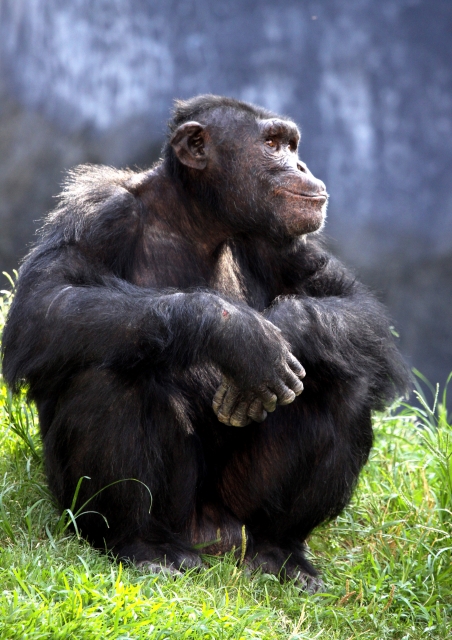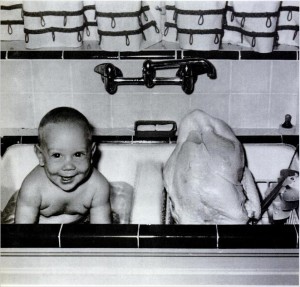Food
Py Kim and Cukes
Not Recommended When Present at Vocational Venues.
More from our Korean Sex Educator here.
Posted By: Paul - Fri Jul 09, 2010 -
Comments (3)
Category: Food, Sexuality
Follies of the Mad Men #114
Posted By: Paul - Mon Jul 05, 2010 -
Comments (8)
Category: Business, Advertising, Products, Food, LGBT, Europe
Weird Science – From Whales To Sails

Sperm whales are still the largest animal ever to have teeth, but today their diet consists mostly of squid – including the infamous giant squid – and therein lies a problem. Whereas most land dwelling creatures live on plant material, or some juicy meaty derivative thereof, and hence are essentially “carbon-neutral”, marine animals from penguins to whales feast upon carbon that was probably sequestered in the oceans hundreds if not thousands of years ago, or has weathered out of rocks that are millions of years old. One upshot of this is that carbon dating is notoriously inaccurate on marine organisms, what scientists call the “reservoir effect”, another is that unlike water breathers such as fish, who return this carbon to the oceans, air breathing animals like whales will release this carbon to the atmosphere as CO2 and so contribute to global warming. However in new research published by the Royal Society of London, researchers have calculated that whales have actually offset their carbon emissions with emissions of another kind. Whale poop is iron rich and comparatively liquid, hence returns the excess iron in the whale’s diet back to the oceans in a form that is readily usable by phytoplankton. The team, led by Trish Lavery of Flinders University in Australia, estimate that sperm whales are responsible for removing 200,000 more tonnes of carbon from the atmosphere annually than they actually emit (Royal Society).
But it’s not all good news for the tree-huggers for while whales might be a boon in the fight against climate change, their free-range, organic farming practices of preference are almost certainly not. In a paper published by the National Academy of Sciences, Jennifer Burney of Stanford University and her colleagues have found that intensive farming is by far the most land and carbon efficient method of agriculture. Because agricultural land use is a major contributor to global warming, increasing the yields from farmland, and thereby reducing the amount of land farmed, strongly outweighed the extra carbon emissions of the intensive farming needed to achieve this. Doing the sums on farm outputs since 1961, the team found that increased yields have produced the same as cultivating an additional area the size of Russia at 1961 levels, which would have led to the release of 590 billion more tonnes of CO2, equal to about a third of all man-made emissions since the industrial revolution (PNAS).
And modern farming may be coming to our rescue in another way, as a source of cheap batteries. Almost since Ben Franklin gave up kite-flying, kids in schools the world over have been making batteries out of apples or a potatoes. Now a trio of researchers from the Hebrew University of Jerusalem, led by Alex Goldberg, have found a way to turn these vegetable power sources from classroom curiosities into a viable product. What’s more amazing is the method they discovered to generate a tenfold increase the output of their potato power-pack, they boil the potato first. How did no-one think of this before (AIP)?
Another new idea, albeit a less welcome one, is that one should prosecute scientists for not knowing everything. At least that seems to be the approach taken by the public prosecutors of the Italian city of L’Aquilla, which last year was hit unexpectedly by an earthquake that killed over 300 people and injured 1600 more. The defendants include the head of Italy’s National Institute of Geophysics and the director of the National Earthquake Center along with four other equally prominent scientists and Bernardo De Bernardinis then deputy head of the Civil Protection Agency, who together are looking at being tried for manslaughter for not alerting the population to the imminent disaster at a meeting held one week before the quake struck. It was Bernardinis, a government official, who claimed in a press conference held immediately after the meeting that the scientists had said there was “no danger”, despite the minutes of the meeting clearly showing that at no time was the chance of a major shock ever ruled out (Nature).
More in extended >>
Posted By: Dumbfounded - Fri Jul 02, 2010 -
Comments (7)
Category: Agriculture, Animals, Dinosaurs and Other Extinct Creatures, Farming, Disasters, Exercise and Fitness, Food, Government, Health, Nature, Natural Resources, Science, Psychology, Excrement
Follies of the Mad Men #113
Posted By: Paul - Wed Jun 30, 2010 -
Comments (3)
Category: Business, Advertising, Products, Food, 1970s, Sex
Weird Animals - Och Aye The Roo!

Of course, this won’t be news to one member of Britain’s thriving rod-fishing community, who this week caught a piranha in his local pond (Guardian).
Another place you might not expect to see exotic creatures is on your lunch menu, but that didn’t stop one restaurant owner in Mesa, AZ from putting “lion burgers” on the menu to celebrate soccer’s World Cup. Cameron Selogie of the Il Vinaio makes his “mane course” with genuine lion meat imported from South Africa, earning him the ire of local animal rights groups and several death threats, but not a reprimand from health officials. According to an FDA spokesman serving lion meat is perfectly legal, as long as it’s not roar (Scotsman).
Slightly luckier than the lions, one cat who has fallen on his feet is Oscar, a housecat from the Isle of Jersey in the UK, widely billed as the “bionic cat” after successfully receiving two artificial hind legs to replace the ones he lost in an altercation with a combine harvester (BBC News).
You might think pitting a rodent like mammal against a 12 tonne Triceratops makes for an equally one-sided match up, but evidence emerged recently that our primitive ancestors occasionally feasted upon dinosaurs. Seventy-five million year old “gnaw marks” of a kind characteristic of early mammals, and belonging to a creature not much bigger than a squirrel, have been found on the fossil bones both of Tricerotops and the crocodile-like predator Champsosaurus (LiveScience).
Sadly today the nearest we get to dinosaur flesh is turkey or chicken, but not all birds were prized solely for their meat. The huia bird of New Zealand for example, was once used to make the feathered head-dresses of Maori chiefs, until predation from accidentally introduced species drove it to extinction around 1907. But if the bird has gone its feathers have not, and one recently became the most expensive feather ever when it sold at auction for NZ$8000, i.e. $4000 American (Telegraph).
More in extended >>
Posted By: Dumbfounded - Mon Jun 28, 2010 -
Comments (4)
Category: Aliens, Animals, Dinosaurs and Other Extinct Creatures, Cryptozoology, Food, Overpriced Merchandise, Pets, Cats, Rants, Warnings, Jeremiads, Prophecies and Cassandra-like Figures, Science, Violence, 1980s
Corn Dogs

Stock up now on batter mix and a special deep fryer, from this vendor.

Posted By: Paul - Sat Jun 19, 2010 -
Comments (3)
Category: Addictions, Animals, Food, Kitsch and Collectibles, Regionalism
Hungry? Mud Snacks Made Easy
Hungry? Not just a type font, I think this is called pica. But I hope never to be so hungry I eat mud treats.Even if they are baked, they still don't sound appetizing. But then again, I've been talked into eating doggie treats because they smelled like vanilla. Dog ice-cream tasted just as bad.
Posted By: gdanea - Tue Jun 08, 2010 -
Comments (11)
Category: Food
World Custard Pie Championship
Posted By: Paul - Sat May 22, 2010 -
Comments (2)
Category: Contests, Races and Other Competitions, Destruction, Food, Europe
The Revenge of the Ojibwe

That's when I noticed the native name given for the product: "Anishinaabe Doodooshaaboo-bimide."
Yeah, right. You just know this is a joke the Native Americans are playing on us politically correct and guilty invaders, trying to get us to pronounce a bunch of doo-wop lyrics and sound like Frankie Valli.
But it does taste great!
Posted By: Paul - Sat May 22, 2010 -
Comments (5)
Category: Food, Languages, Native Americans
Poulet a la Baby Poop
"Yes, Mr. Dithers, we did happen to clean the chicken in the same sink where Junior had his bath. Why do you ask? What do you mean, Dagwood won't be getting that raise?!?"Alternate interpretation: "Cannibals? Us?"
For the full story, visit here.
Posted By: Paul - Fri May 07, 2010 -
Comments (3)
Category: Food, Magazines, Babies and Toddlers, 1950s

| Who We Are |
|---|
| Alex Boese Alex is the creator and curator of the Museum of Hoaxes. He's also the author of various weird, non-fiction, science-themed books such as Elephants on Acid and Psychedelic Apes. Paul Di Filippo Paul has been paid to put weird ideas into fictional form for over thirty years, in his career as a noted science fiction writer. He has recently begun blogging on many curious topics with three fellow writers at The Inferior 4+1. Contact Us |






